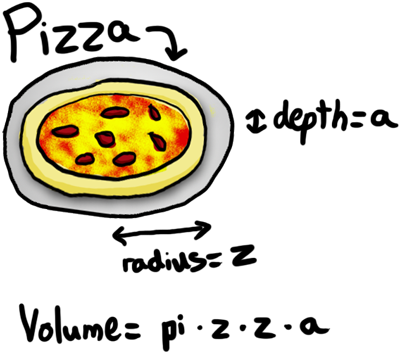Today*, obviously right after I had finished my home-cooked lunch, my labmates and I discovered some free leftover pizza in the kitchen area. While it’s a given that most people love pizza, it is even truer that academics love pizza. And mathematicians, a special breed of academics, are no exception. Their love for pizza is so pronounced that they named a mathematical theorem after it: the pizza theorem.
The pizza theorem states that if you cut a disk in a number of pieces that is divisible by for and greater than or equal to 8, you get two areas of equal size by alternating the slices of the disk. In other words: the sum of the areas of the odd-numbered sectors equals the sum of the areas of the even-numbered sectors.

What it means is this: if you slice a pizza into a certain number of slices, and that number is 8, 12, 16 or 20 (other multiples of 4 are also possible, but let’s be honest, that gets pretty difficult to cut a pizza into more than 20 pieces), two people will end up eating exactly the same amount of pizza by eating alternating slices. The slicing does not have to go exactly through the center of the pizza (that’s kind of hard to do precisely), as long as all cuts go through the same point.
The pizza-inspired math does not end there. Apparently, you can prove that if a pizza is divided unevenly, the diner who gets the most pizza actually gets the least crust – a 6-year-old’s dream!
Here’s another: a pizza sliced according to the pizza theorem can be shared equally among n/4 people (with n the number of slices). So 8 pieces can be shared equally among 2 people. 12 slices can be shared between either 2 or 3 people. 16 slices between 4 people, and 20 between 5. Good to remember for those pizza parties!

Okay, I’ll leave you with some pizza facts:
- An approximate total area of 100 acres of pizza is eaten in the US every year. That’s about 120 football fields (the standard method of size measurements). That means that if the whole of the US was covered in pizza, it would take 2.43 million years to eat it all, considering the eating rate remained constant.
- Depending on how you define a “pizza”, the origin of pizza might not be Italian! Ancient Greeks and Egyptians were flatbreads topped with olive oil and spices. So kind of like pizza? (Nah, not really.)
- Another math-pizza-merger is called the lazy caterer’s sequence, a sequence that counts the maximum pieces of pizza you can obtain by a given number of straight slices.
- In 2001, which was mostly a Pizza Hut publication stunt, the first pizza was delivered to outer space. Cosmonaut Yuri Usachov was the lucky recipient.
- The first computer-ordered pizza was delivered in 1974. Not through the internet though; the Artifical Language Laboratory at Michigan State was testing out its “speaking computer”.
- If you thought the fancy pizza dough spinning and throwing was just a tourist attraction, you’re not entirely right. It’s actually the best way to create a uniform disk of dough.
Obviously, I had a slice of free pizza. You might have heard of a dessert stomach, but I also have a pizza stomach. (There was also free cake later in the day, to satisfy that dessert stomach).
_____________________________________
* “Today” as in when I wrote the first draft.
Pizza facts from:
http://mentalfloss.com/article/69737/46-mouthwatering-facts-about-pizza and https://denirospizza.com/blog-post/facts-you-didnt-know-about-pizza/


